AD210AN Isolation Amplifier: Pinout, Functions, Datasheet
1 Channels 5mA per Channel 30pA 120 dB Instrumentational OP Amps 15V 14.25V~15.75V AD210 12 Pins 38-DIP (0.800, 20.32mm), 12 Leads









1 Channels 5mA per Channel 30pA 120 dB Instrumentational OP Amps 15V 14.25V~15.75V AD210 12 Pins 38-DIP (0.800, 20.32mm), 12 Leads
The AD210AN is a Precision, Wide Bandwidth 3-Port Isolation Amplifier. This article will unlock its pinout, datasheet, parts comparison and more details about AD210AN.
AD210AN Pinout
Pin | Designation | Function |
1 | Vo | Output |
2 | Ocom | Output Common |
3 | +VOSS | +Isolated Power @ Output |
4 | –VOSS | -Isolated Power @ Output |
14 | +VISS | +Isolated Power @ Input |
15 | –VISS | -Isolated Power @ Input |
16 | FB | Input Feedback |
17 | –IN | –Input |
18 | Icom . | Input Common |
19 | +IN | +Input |
29 | Pwr Com | Power Common |
30 | Pwr | Power Input |
AD210AN CAD Model
Symbol
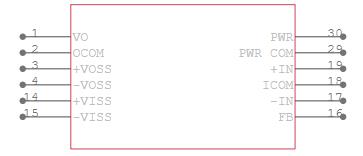
AD210AN Symbol
Footprint
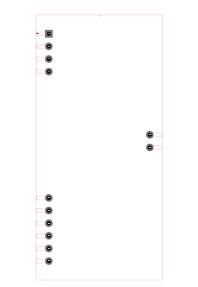
AD210AN Footprint
3D Model

AD210 3D Model
AD210AN Overview
The AD210AN is the latest member of a new generation of low-cost, high-performance isolation amplifiers. This three-part, wide bandwidth isolation amplifier is manufactured with surface-mounted components in an automated assembly process. The AD210AN combines design expertise with state-of-the-art manufacturing technology to produce an extremely compact and economical isolator whose performance and abundant user features far exceed those offered in more expensive devices.
AD210AN Applications
Multichannel Data Acquisition
High Voltage Instrumentation Amplifier
Current Shunt Measurements
Process Signal Isolation
AD210AN Functional Block Diagram
Figure 1 depicts below the AD210AN basic block diagram. A +15 V supply is connected to the power port, and a 50 kHz carrier frequency supplies 15 V isolated power to both the input and output ports. The uncommitted input amplifier can provide gain or buffer to the AD210AN. The full-wave modulator converts the signal to the carrier frequency, which is then applied to transformer T1. The synchronous demodulator reconstructs the input signal in the output port. A 20 kHz three-pole filter is used to reduce output noise and ripple. Finally, an output buffer outputs a low-impedance signal capable of driving a 2 kΩ load.
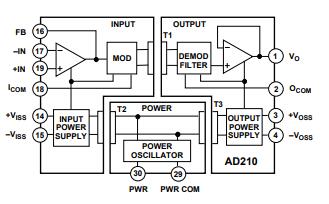
Figure1.AD210AN Functional Block Diagram
AD210AN Usages
The AD210AN is extremely simple to use in a wide variety of applications. The AD210AN, which is powered by a single +15 V power supply, performs admirably as an input or output isolator in single and multichannel configurations.
Input Configurations: Figure 2 depicts the basic unity gain configuration for signals up to 10 V. The figures below depict additional input amplifier variations. Figure 3 shows how to obtain gain while maintaining a very high input impedance for lower signal levels.
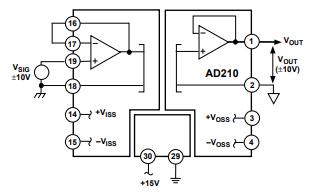
Figure2.Basic Unity Gain Configuration
In an inverting application, the high input impedance of the circuits shown in Figures 2 and 3 can be maintained. Because the AD210AN is a three-port isolator, signal inversion can be achieved by swapping the input and output leads.
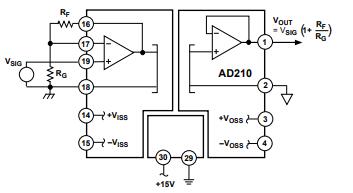
Figure3.Input Configuration for G
Figure 4 shows how to accommodate current inputs or sum currents or voltages. This circuit configuration can also be used for signals greater than ±10 V. For example, a ±100 V input span can be handled with RF = 20 kΩ and RS1 = 200 kΩ.

Figure4.Summing or Current Input Configuration
AD210AN Dimensions
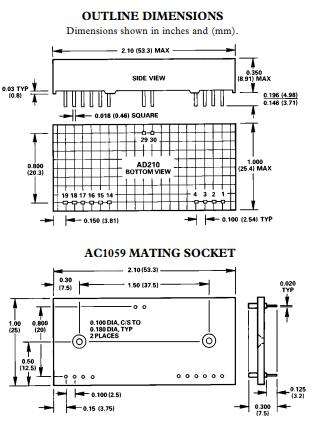
AD210AN Dimensions
Datasheet PDF
- Datasheets :
- PCN Packaging :
- ConflictMineralStatement :
Specifications
- TypeParameter
- Lifecycle Status
Lifecycle Status refers to the current stage of an electronic component in its product life cycle, indicating whether it is active, obsolete, or transitioning between these states. An active status means the component is in production and available for purchase. An obsolete status indicates that the component is no longer being manufactured or supported, and manufacturers typically provide a limited time frame for support. Understanding the lifecycle status is crucial for design engineers to ensure continuity and reliability in their projects.
PRODUCTION (Last Updated: 1 month ago) - Factory Lead Time20 Weeks
- Mount
In electronic components, the term "Mount" typically refers to the method or process of physically attaching or fixing a component onto a circuit board or other electronic device. This can involve soldering, adhesive bonding, or other techniques to secure the component in place. The mounting process is crucial for ensuring proper electrical connections and mechanical stability within the electronic system. Different components may have specific mounting requirements based on their size, shape, and function, and manufacturers provide guidelines for proper mounting procedures to ensure optimal performance and reliability of the electronic device.
Through Hole - Mounting Type
The "Mounting Type" in electronic components refers to the method used to attach or connect a component to a circuit board or other substrate, such as through-hole, surface-mount, or panel mount.
Through Hole - Package / Case
refers to the protective housing that encases an electronic component, providing mechanical support, electrical connections, and thermal management.
38-DIP (0.800, 20.32mm), 12 Leads - Number of Pins12
- Number of Elements2
- Operating Temperature
The operating temperature is the range of ambient temperature within which a power supply, or any other electrical equipment, operate in. This ranges from a minimum operating temperature, to a peak or maximum operating temperature, outside which, the power supply may fail.
-25°C~85°C - Packaging
Semiconductor package is a carrier / shell used to contain and cover one or more semiconductor components or integrated circuits. The material of the shell can be metal, plastic, glass or ceramic.
Tube - Pbfree Code
The "Pbfree Code" parameter in electronic components refers to the code or marking used to indicate that the component is lead-free. Lead (Pb) is a toxic substance that has been widely used in electronic components for many years, but due to environmental concerns, there has been a shift towards lead-free alternatives. The Pbfree Code helps manufacturers and users easily identify components that do not contain lead, ensuring compliance with regulations and promoting environmentally friendly practices. It is important to pay attention to the Pbfree Code when selecting electronic components to ensure they meet the necessary requirements for lead-free applications.
no - Part Status
Parts can have many statuses as they progress through the configuration, analysis, review, and approval stages.
Active - Moisture Sensitivity Level (MSL)
Moisture Sensitivity Level (MSL) is a standardized rating that indicates the susceptibility of electronic components, particularly semiconductors, to moisture-induced damage during storage and the soldering process, defining the allowable exposure time to ambient conditions before they require special handling or baking to prevent failures
1 (Unlimited) - Number of Terminations12
- Termination
Termination in electronic components refers to the practice of matching the impedance of a circuit to prevent signal reflections and ensure maximum power transfer. It involves the use of resistors or other components at the end of transmission lines or connections. Proper termination is crucial in high-frequency applications to maintain signal integrity and reduce noise.
Through Hole - ECCN Code
An ECCN (Export Control Classification Number) is an alphanumeric code used by the U.S. Bureau of Industry and Security to identify and categorize electronic components and other dual-use items that may require an export license based on their technical characteristics and potential for military use.
EAR99 - Resistance
Resistance is a fundamental property of electronic components that measures their opposition to the flow of electric current. It is denoted by the symbol "R" and is measured in ohms (Ω). Resistance is caused by the collisions of electrons with atoms in a material, which generates heat and reduces the flow of current. Components with higher resistance will impede the flow of current more than those with lower resistance. Resistance plays a crucial role in determining the behavior and functionality of electronic circuits, such as limiting current flow, voltage division, and controlling power dissipation.
1 TΩ - Terminal Position
In electronic components, the term "Terminal Position" refers to the physical location of the connection points on the component where external electrical connections can be made. These connection points, known as terminals, are typically used to attach wires, leads, or other components to the main body of the electronic component. The terminal position is important for ensuring proper connectivity and functionality of the component within a circuit. It is often specified in technical datasheets or component specifications to help designers and engineers understand how to properly integrate the component into their circuit designs.
DUAL - Number of Functions1
- Supply Voltage
Supply voltage refers to the electrical potential difference provided to an electronic component or circuit. It is crucial for the proper operation of devices, as it powers their functions and determines performance characteristics. The supply voltage must be within specified limits to ensure reliability and prevent damage to components. Different electronic devices have specific supply voltage requirements, which can vary widely depending on their design and intended application.
15V - Base Part Number
The "Base Part Number" (BPN) in electronic components serves a similar purpose to the "Base Product Number." It refers to the primary identifier for a component that captures the essential characteristics shared by a group of similar components. The BPN provides a fundamental way to reference a family or series of components without specifying all the variations and specific details.
AD210 - Pin Count
a count of all of the component leads (or pins)
12 - Operating Supply Voltage
The voltage level by which an electrical system is designated and to which certain operating characteristics of the system are related.
15V - Number of Channels1
- Operating Supply Current
Operating Supply Current, also known as supply current or quiescent current, is a crucial parameter in electronic components that indicates the amount of current required for the device to operate under normal conditions. It represents the current drawn by the component from the power supply while it is functioning. This parameter is important for determining the power consumption of the component and is typically specified in datasheets to help designers calculate the overall power requirements of their circuits. Understanding the operating supply current is essential for ensuring proper functionality and efficiency of electronic systems.
50mA - Nominal Supply Current
Nominal current is the same as the rated current. It is the current drawn by the motor while delivering rated mechanical output at its shaft.
50mA - Slew Rate
the maximum rate of output voltage change per unit time.
1V/μs - Amplifier Type
Amplifier Type refers to the classification or categorization of amplifiers based on their design, functionality, and characteristics. Amplifiers are electronic devices that increase the amplitude of a signal, such as voltage or current. The type of amplifier determines its specific application, performance capabilities, and operating characteristics. Common types of amplifiers include operational amplifiers (op-amps), power amplifiers, audio amplifiers, and radio frequency (RF) amplifiers. Understanding the amplifier type is crucial for selecting the right component for a particular circuit or system design.
Isolation - Common Mode Rejection Ratio
Common Mode Rejection Ratio (CMRR) is a measure of the ability of a differential amplifier to reject input signals that are common to both input terminals. It is defined as the ratio of the differential gain to the common mode gain. A high CMRR indicates that the amplifier can effectively eliminate noise and interference that affects both inputs simultaneously, enhancing the fidelity of the amplified signal. CMRR is typically expressed in decibels (dB), with higher values representing better performance in rejecting common mode signals.
120 dB - Current - Input Bias
The parameter "Current - Input Bias" in electronic components refers to the amount of current required at the input terminal of a device to maintain proper operation. It is a crucial specification as it determines the minimum input current needed for the component to function correctly. Input bias current can affect the performance and accuracy of the device, especially in precision applications where small signal levels are involved. It is typically specified in datasheets for operational amplifiers, transistors, and other semiconductor devices to provide users with important information for circuit design and analysis.
30pA - Voltage - Supply, Single/Dual (±)
The parameter "Voltage - Supply, Single/Dual (±)" in electronic components refers to the power supply voltage required for the proper operation of the component. This parameter indicates whether the component requires a single power supply voltage (e.g., 5V) or a dual power supply voltage (e.g., ±15V). For components that require a single power supply voltage, only one voltage level is needed for operation. On the other hand, components that require a dual power supply voltage need both positive and negative voltage levels to function correctly.Understanding the voltage supply requirements of electronic components is crucial for designing and integrating them into circuits to ensure proper functionality and prevent damage due to incorrect voltage levels.
14.25V~15.75V - Output Current per Channel
Output Current per Channel is a specification commonly found in electronic components such as amplifiers, audio interfaces, and power supplies. It refers to the maximum amount of electrical current that can be delivered by each individual output channel of the component. This parameter is important because it determines the capacity of the component to drive connected devices or loads. A higher output current per channel means the component can deliver more power to connected devices, while a lower output current may limit the performance or functionality of the component in certain applications. It is crucial to consider the output current per channel when selecting electronic components to ensure they can meet the power requirements of the intended system or setup.
5mA - Input Offset Voltage (Vos)
Input Offset Voltage (Vos) is a key parameter in electronic components, particularly in operational amplifiers. It refers to the voltage difference that must be applied between the two input terminals of the amplifier to nullify the output voltage when the input terminals are shorted together. In simpler terms, it represents the voltage required to bring the output of the amplifier to zero when there is no input signal present. Vos is an important parameter as it can introduce errors in the output signal of the amplifier, especially in precision applications where accuracy is crucial. Minimizing Vos is essential to ensure the amplifier operates with high precision and accuracy.
15mV - Bandwidth
In electronic components, "Bandwidth" refers to the range of frequencies over which the component can effectively operate or pass signals without significant loss or distortion. It is a crucial parameter for devices like amplifiers, filters, and communication systems. The bandwidth is typically defined as the difference between the upper and lower frequencies at which the component's performance meets specified criteria, such as a certain level of signal attenuation or distortion. A wider bandwidth indicates that the component can handle a broader range of frequencies, making it more versatile for various applications. Understanding the bandwidth of electronic components is essential for designing and optimizing circuits to ensure proper signal transmission and reception within the desired frequency range.
20 kHz - Voltage Gain
Voltage gain is a measure of how much an electronic component or circuit amplifies an input voltage signal to produce an output voltage signal. It is typically expressed as a ratio or in decibels (dB). A higher voltage gain indicates a greater amplification of the input signal. Voltage gain is an important parameter in amplifiers, where it determines the level of amplification provided by the circuit. It is calculated by dividing the output voltage by the input voltage and is a key factor in determining the overall performance and functionality of electronic devices.
40dB - -3db Bandwidth
The "-3dB bandwidth" of an electronic component refers to the frequency range over which the component's output signal power is reduced by 3 decibels (dB) compared to its maximum output power. This parameter is commonly used to describe the frequency response of components such as amplifiers, filters, and other signal processing devices. The -3dB point is significant because it represents the half-power point, where the output signal power is reduced to half of its maximum value. Understanding the -3dB bandwidth is important for designing and analyzing electronic circuits to ensure that signals are accurately processed within the desired frequency range.
15MHz - Dual Supply Voltage
Dual Supply Voltage refers to an electronic component's requirement for two separate power supply voltages, typically one positive and one negative. This configuration is commonly used in operational amplifiers, analog circuits, and certain digital devices to allow for greater signal handling capabilities and improved performance. The use of dual supply voltages enables the device to process bipolar signals, thereby enhancing its functionality in various applications.
15V - Isolation Voltage
Isolation voltage refers to a test of the ability of an insulator to minimize the flow of electric current with a high applied voltage.
15V - Common Mode Voltage-Max
Common Mode Voltage-Max is the maximum voltage level that can be applied to the common mode input of a differential amplifier or operational amplifier without causing distortion or signal degradation. It refers to the highest allowable voltage that is present equally on both inputs with respect to the ground. This parameter is crucial for ensuring accurate signal processing and preventing issues in applications where differential signaling is employed. Exceeding this limit can lead to malfunction or damage to the electronic component.
3500V - Height8.91mm
- Length53.3mm
- Width25mm
- REACH SVHC
The parameter "REACH SVHC" in electronic components refers to the compliance with the Registration, Evaluation, Authorization, and Restriction of Chemicals (REACH) regulation regarding Substances of Very High Concern (SVHC). SVHCs are substances that may have serious effects on human health or the environment, and their use is regulated under REACH to ensure their safe handling and minimize their impact.Manufacturers of electronic components need to declare if their products contain any SVHCs above a certain threshold concentration and provide information on the safe use of these substances. This information allows customers to make informed decisions about the potential risks associated with using the components and take appropriate measures to mitigate any hazards.Ensuring compliance with REACH SVHC requirements is essential for electronics manufacturers to meet regulatory standards, protect human health and the environment, and maintain transparency in their supply chain. It also demonstrates a commitment to sustainability and responsible manufacturing practices in the electronics industry.
No SVHC - Radiation Hardening
Radiation hardening is the process of making electronic components and circuits resistant to damage or malfunction caused by high levels of ionizing radiation, especially for environments in outer space (especially beyond the low Earth orbit), around nuclear reactors and particle accelerators, or during nuclear accidents or nuclear warfare.
No - RoHS Status
RoHS means “Restriction of Certain Hazardous Substances” in the “Hazardous Substances Directive” in electrical and electronic equipment.
Non-RoHS Compliant - Lead Free
Lead Free is a term used to describe electronic components that do not contain lead as part of their composition. Lead is a toxic material that can have harmful effects on human health and the environment, so the electronics industry has been moving towards lead-free components to reduce these risks. Lead-free components are typically made using alternative materials such as silver, copper, and tin. Manufacturers must comply with regulations such as the Restriction of Hazardous Substances (RoHS) directive to ensure that their products are lead-free and environmentally friendly.
Contains Lead
Parts with Similar Specs
- ImagePart NumberManufacturerPackage / CaseNumber of PinsSlew RateInput Offset Voltage (Vos)Common Mode Rejection RatioSupply VoltageOperating Supply CurrentRadiation HardeningView Compare
AD210AN
38-DIP (0.800, 20.32mm), 12 Leads
12
1V/μs
15 mV
120 dB
15 V
50 mA
No
14-DIP (0.300, 7.62mm)
14
1V/μs
5 μV
120 dB
5 V
1 mA
No
14-DIP (0.300, 7.62mm)
14
2.5V/μs
5 μV
120 dB
5 V
2 mA
No
38-DIP (0.800, 20.32mm), 12 Leads
12
1V/μs
5 mV
120 dB
15 V
50 mA
No
38-DIP (0.800, 20.32mm), 12 Leads
12
1V/μs
5 mV
120 dB
15 V
50 mA
No
Conclusion
The AD210AN offers complete isolation, with both signal and power isolation provided by internal transformer coupling. Unlike optically coupled isolation devices, the AD210's functionally complete design, powered by a single +15 V supply, eliminates the need for an external DC/DC converter. The AD210AN's true three-port design allows it to be used as an input or output isolator in single or multichannel applications. Under sustained common-mode stress, the AD210AN will maintain its high performance.
 PN2222 Vs. 2N2222: They Are Equivalents In Most Cases
PN2222 Vs. 2N2222: They Are Equivalents In Most Cases01 March 20229297
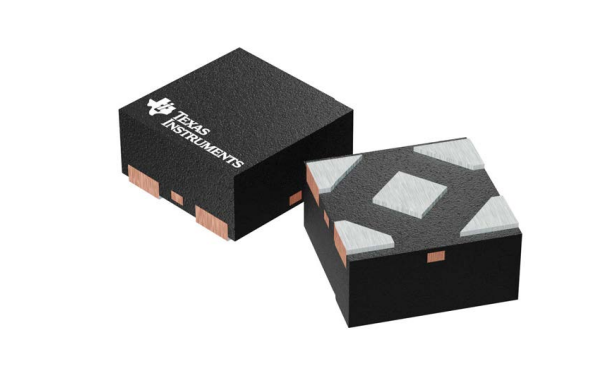 SN74LVC1G08DBVR: Overview, Applications and Datasheet
SN74LVC1G08DBVR: Overview, Applications and Datasheet21 November 20231029
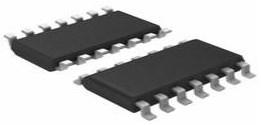 UC3844 PWM Controller: Uses, Pinout and Datasheet
UC3844 PWM Controller: Uses, Pinout and Datasheet11 August 20214890
 AD574: A High-Performance Analog to Digital Converter for Military Applications
AD574: A High-Performance Analog to Digital Converter for Military Applications06 March 2024122
 TC1044SCPA Charge Pump Switching Regulator IC: Pinout, Equivalent, TC1044SCPA VS LM2574N-ADJG
TC1044SCPA Charge Pump Switching Regulator IC: Pinout, Equivalent, TC1044SCPA VS LM2574N-ADJG09 February 20222132
 MB10S Bridge Rectifier: Circuit, Pinout, and Datasheet
MB10S Bridge Rectifier: Circuit, Pinout, and Datasheet15 November 20214901
![Is LM317 better than LM7805?[video+FAQ]](https://res.utmel.com/Images/Article/5cafb24b-3f28-4935-b123-c59a0f9c15eb.jpg) Is LM317 better than LM7805?[video+FAQ]
Is LM317 better than LM7805?[video+FAQ]27 April 20228131
 A Comprehensive Guide to the Atmel AT89LP51RB2/RC2/IC2 Microcontroller
A Comprehensive Guide to the Atmel AT89LP51RB2/RC2/IC2 Microcontroller29 February 2024127
 Solar Inverter: Definition, Types and Costs
Solar Inverter: Definition, Types and Costs01 February 20214051
 A Guide to Selecting the Ideal Microphone for Your Audio Needs
A Guide to Selecting the Ideal Microphone for Your Audio Needs15 May 20231984
 Shunt Resistors in Automotive and Power Electronics: A Comprehensive Guide to Selection and Applications
Shunt Resistors in Automotive and Power Electronics: A Comprehensive Guide to Selection and Applications04 August 20252645
 The Global Talent Pool for Major Chip Manufacturing Is Still Far From Adequate
The Global Talent Pool for Major Chip Manufacturing Is Still Far From Adequate29 April 2022517
 Nearly 60% of the Industry Believes That the Chip Shortage Will Be Solved in 2023 at the Earliest
Nearly 60% of the Industry Believes That the Chip Shortage Will Be Solved in 2023 at the Earliest21 April 2022854
 Texas Semiconductor Summit: A Step Towards Overcoming Chip Shortage
Texas Semiconductor Summit: A Step Towards Overcoming Chip Shortage14 October 20231005
 Comparing Popular Jumper Wires for Electronics Projects
Comparing Popular Jumper Wires for Electronics Projects10 July 2025644
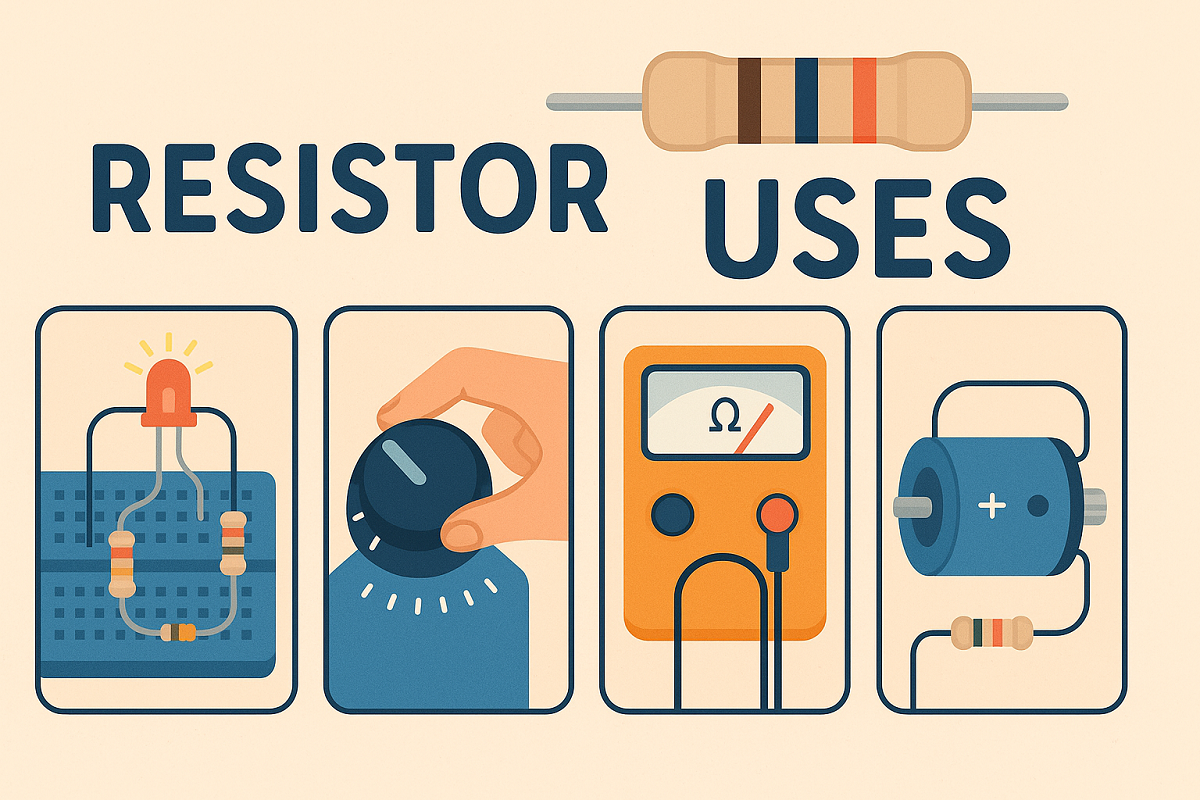 What is a Resistor Used For?
What is a Resistor Used For?01 August 2025845
Analog Devices Inc.
In Stock: 2629
United States
China
Canada
Japan
Russia
Germany
United Kingdom
Singapore
Italy
Hong Kong(China)
Taiwan(China)
France
Korea
Mexico
Netherlands
Malaysia
Austria
Spain
Switzerland
Poland
Thailand
Vietnam
India
United Arab Emirates
Afghanistan
Åland Islands
Albania
Algeria
American Samoa
Andorra
Angola
Anguilla
Antigua & Barbuda
Argentina
Armenia
Aruba
Australia
Azerbaijan
Bahamas
Bahrain
Bangladesh
Barbados
Belarus
Belgium
Belize
Benin
Bermuda
Bhutan
Bolivia
Bonaire, Sint Eustatius and Saba
Bosnia & Herzegovina
Botswana
Brazil
British Indian Ocean Territory
British Virgin Islands
Brunei
Bulgaria
Burkina Faso
Burundi
Cabo Verde
Cambodia
Cameroon
Cayman Islands
Central African Republic
Chad
Chile
Christmas Island
Cocos (Keeling) Islands
Colombia
Comoros
Congo
Congo (DRC)
Cook Islands
Costa Rica
Côte d’Ivoire
Croatia
Cuba
Curaçao
Cyprus
Czechia
Denmark
Djibouti
Dominica
Dominican Republic
Ecuador
Egypt
El Salvador
Equatorial Guinea
Eritrea
Estonia
Eswatini
Ethiopia
Falkland Islands
Faroe Islands
Fiji
Finland
French Guiana
French Polynesia
Gabon
Gambia
Georgia
Ghana
Gibraltar
Greece
Greenland
Grenada
Guadeloupe
Guam
Guatemala
Guernsey
Guinea
Guinea-Bissau
Guyana
Haiti
Honduras
Hungary
Iceland
Indonesia
Iran
Iraq
Ireland
Isle of Man
Israel
Jamaica
Jersey
Jordan
Kazakhstan
Kenya
Kiribati
Kosovo
Kuwait
Kyrgyzstan
Laos
Latvia
Lebanon
Lesotho
Liberia
Libya
Liechtenstein
Lithuania
Luxembourg
Macao(China)
Madagascar
Malawi
Maldives
Mali
Malta
Marshall Islands
Martinique
Mauritania
Mauritius
Mayotte
Micronesia
Moldova
Monaco
Mongolia
Montenegro
Montserrat
Morocco
Mozambique
Myanmar
Namibia
Nauru
Nepal
New Caledonia
New Zealand
Nicaragua
Niger
Nigeria
Niue
Norfolk Island
North Korea
North Macedonia
Northern Mariana Islands
Norway
Oman
Pakistan
Palau
Palestinian Authority
Panama
Papua New Guinea
Paraguay
Peru
Philippines
Pitcairn Islands
Portugal
Puerto Rico
Qatar
Réunion
Romania
Rwanda
Samoa
San Marino
São Tomé & Príncipe
Saudi Arabia
Senegal
Serbia
Seychelles
Sierra Leone
Sint Maarten
Slovakia
Slovenia
Solomon Islands
Somalia
South Africa
South Sudan
Sri Lanka
St Helena, Ascension, Tristan da Cunha
St. Barthélemy
St. Kitts & Nevis
St. Lucia
St. Martin
St. Pierre & Miquelon
St. Vincent & Grenadines
Sudan
Suriname
Svalbard & Jan Mayen
Sweden
Syria
Tajikistan
Tanzania
Timor-Leste
Togo
Tokelau
Tonga
Trinidad & Tobago
Tunisia
Turkey
Turkmenistan
Turks & Caicos Islands
Tuvalu
U.S. Outlying Islands
U.S. Virgin Islands
Uganda
Ukraine
Uruguay
Uzbekistan
Vanuatu
Vatican City
Venezuela
Wallis & Futuna
Yemen
Zambia
Zimbabwe













